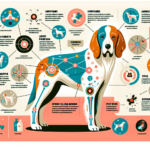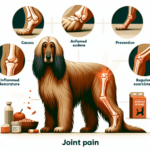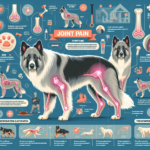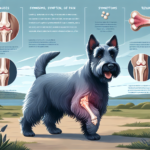Spinone Italiano Joint Pain: Causes, Symptoms, Prevention, and Treatment

Introduction
The Spinone Italiano, often simply referred to as the Spinone, is a versatile and ancient breed originating from Italy. Known for its distinctive wiry coat, soulful eyes, and robust build, the Spinone Italiano has a rich history as a hunting and retrieving dog. This breed is celebrated for its gentle temperament, intelligence, and endurance, making it a beloved companion for both families and hunters alike.
While the Spinone Italiano is generally a healthy breed, it is not immune to certain health issues. Among these, joint pain is a significant concern that can affect the quality of life for these dogs. Understanding the causes, symptoms, prevention, and treatment of joint pain is crucial for owners who wish to ensure their Spinone Italiano remains active and comfortable throughout its life.
Joint health is particularly important for the Spinone Italiano due to its active lifestyle and working heritage. Proper joint care can help prevent debilitating conditions that could hinder the dog’s mobility and overall well-being.
Breed-Specific Joint Pain Risks
Genetic Predisposition
The Spinone Italiano, like many large breeds, is genetically predisposed to several joint-related issues. Hip dysplasia, a condition where the hip joint does not fit properly into the hip socket, is relatively common in this breed. Elbow dysplasia, which involves abnormal development of the elbow joint, can also occur. Both conditions can lead to arthritis and chronic pain if not managed properly.
Age-Related Risks
As the Spinone Italiano ages, the risk of developing joint pain increases. Senior dogs are more prone to arthritis, a degenerative joint disease that causes inflammation and pain. Owners should be vigilant about monitoring their Spinone’s joint health as they approach middle age, typically around 6-8 years old, and into their senior years.
Activity Level and Joint Stress
The Spinone Italiano is an active breed that thrives on physical activity. Whether used for hunting, agility, or simply as a family pet, their high energy levels can put significant stress on their joints. Activities that involve running, jumping, and sudden changes in direction can exacerbate joint issues, especially if the dog is not properly conditioned or if underlying joint problems exist.
Common Symptoms of Joint Pain in Spinone Italiano
General Symptoms
- Limping or favoring one leg
- Stiffness, especially after rest or sleep
- Reluctance to climb stairs or jump
- Decreased activity or playfulness
- Visible discomfort or pain when moving
- Swelling around the joints
Breed-Specific Symptoms
In the Spinone Italiano, joint pain may manifest more subtly due to their stoic nature. Owners might notice a gradual decrease in their dog’s enthusiasm for physical activities or a slight change in gait. Given their history as working dogs, any reluctance to perform tasks they previously enjoyed should be taken seriously.
When to Consult a Vet
If any of the above symptoms are observed, it is essential to consult a veterinarian. Early intervention can prevent further deterioration and improve the dog’s quality of life. Regular veterinary check-ups are also recommended to monitor joint health, especially as the dog ages.
Preventive Measures for Joint Health
Exercise Recommendations
Maintaining an appropriate level of exercise is crucial for the Spinone Italiano. Low-impact activities such as swimming and controlled walking are excellent for joint health. Avoid high-impact exercises like excessive running or jumping, especially on hard surfaces. Regular, moderate exercise helps maintain muscle mass and joint flexibility without overloading the joints.
Dietary Suggestions
A balanced diet rich in essential nutrients supports overall health and joint function. Foods containing glucosamine and chondroitin can help maintain cartilage health. Omega-3 fatty acids, found in fish oil, have anti-inflammatory properties that can alleviate joint pain. Consult with a veterinarian to determine the best diet and supplements for your Spinone Italiano.
Weight Management
Maintaining a healthy weight is vital for reducing joint stress. Excess weight can exacerbate joint problems and lead to earlier onset of arthritis. Regularly monitor your dog’s weight and adjust their diet and exercise routine as needed to keep them within a healthy weight range.
Early Screening and Monitoring
Early screening for joint issues can help catch problems before they become severe. Regular veterinary check-ups should include joint assessments, especially for dogs with a family history of joint problems. X-rays and other diagnostic tools can be used to detect early signs of dysplasia or arthritis.
Treatment Options for Joint Pain
Non-Surgical Treatments
Non-surgical treatments are often the first line of defense against joint pain. These can include:
- Medications: Anti-inflammatory drugs and pain relievers can help manage symptoms.
- Physical Therapy: Exercises and therapies designed to improve joint function and reduce pain.
- Lifestyle Adjustments: Modifying activity levels and incorporating joint-friendly exercises.
Surgical Options
In severe cases, surgical intervention may be necessary. Common surgeries for joint issues in the Spinone Italiano include:
- Hip Replacement: Replacing the damaged hip joint with an artificial one.
- Arthroscopy: A minimally invasive procedure to clean out the joint.
- Osteotomy: Cutting and realigning bones to improve joint function.
Alternative Therapies
Alternative therapies can complement traditional treatments and provide additional relief. These may include:
- Acupuncture: Using needles to stimulate specific points on the body to relieve pain.
- Hydrotherapy: Water-based exercises that reduce joint stress while improving strength and flexibility.
- Massage: Therapeutic massage to improve circulation and reduce muscle tension around the joints.
Lifestyle and Management Tips
Daily Care Routine
A consistent daily care routine can help manage joint pain in the Spinone Italiano. This might include:
- Gentle morning walks to loosen stiff joints
- Regular, low-impact play sessions
- Administering prescribed medications or supplements
- Providing a comfortable resting area with orthopedic bedding
Modifying the Home Environment
Making the home environment more joint-friendly can significantly improve the dog’s comfort. Consider the following modifications:
- Installing ramps to avoid stairs
- Using non-slip mats to prevent falls
- Providing elevated food and water bowls to reduce strain
- Ensuring a warm, draft-free sleeping area
Long-Term Management
Long-term management of joint pain involves regular monitoring and adjustments to care routines. Keep up with veterinary appointments, maintain a healthy weight, and continue with appropriate exercise and dietary plans. Staying proactive can help your Spinone Italiano lead a happy and active life despite joint issues.
FAQs About Spinone Italiano and Joint Pain
What are the early signs of joint pain in Spinone Italiano?
Early signs include limping, stiffness, reluctance to move, and decreased activity levels. If you notice any of these symptoms, consult your veterinarian for an evaluation.
Can joint pain in Spinone Italiano be prevented?
While genetic predispositions cannot be entirely prevented, maintaining a healthy weight, providing appropriate exercise, and regular veterinary check-ups can significantly reduce the risk and severity of joint pain.
Are there specific foods that can help with joint health?
Yes, foods rich in glucosamine, chondroitin, and omega-3 fatty acids can support joint health. Consult your veterinarian for dietary recommendations tailored to your dog’s needs.
Is surgery always necessary for joint pain in Spinone Italiano?
No, surgery is typically considered a last resort. Many cases of joint pain can be managed with non-surgical treatments such as medications, physical therapy, and lifestyle adjustments.
How often should I take my Spinone Italiano to the vet for joint health check-ups?
Regular check-ups are recommended at least once a year, but more frequent visits may be necessary as your dog ages or if they show signs of joint pain.
Conclusion
Joint pain is a significant concern for the Spinone Italiano, but with proper care and attention, it can be managed effectively. By understanding the causes, symptoms, prevention, and treatment options, owners can ensure their Spinone Italiano remains active and comfortable throughout its life. Regular veterinary consultations, a balanced diet, appropriate exercise, and a supportive home environment are key to maintaining joint health. Taking proactive measures can help your Spinone Italiano lead a happy, pain-free life.




